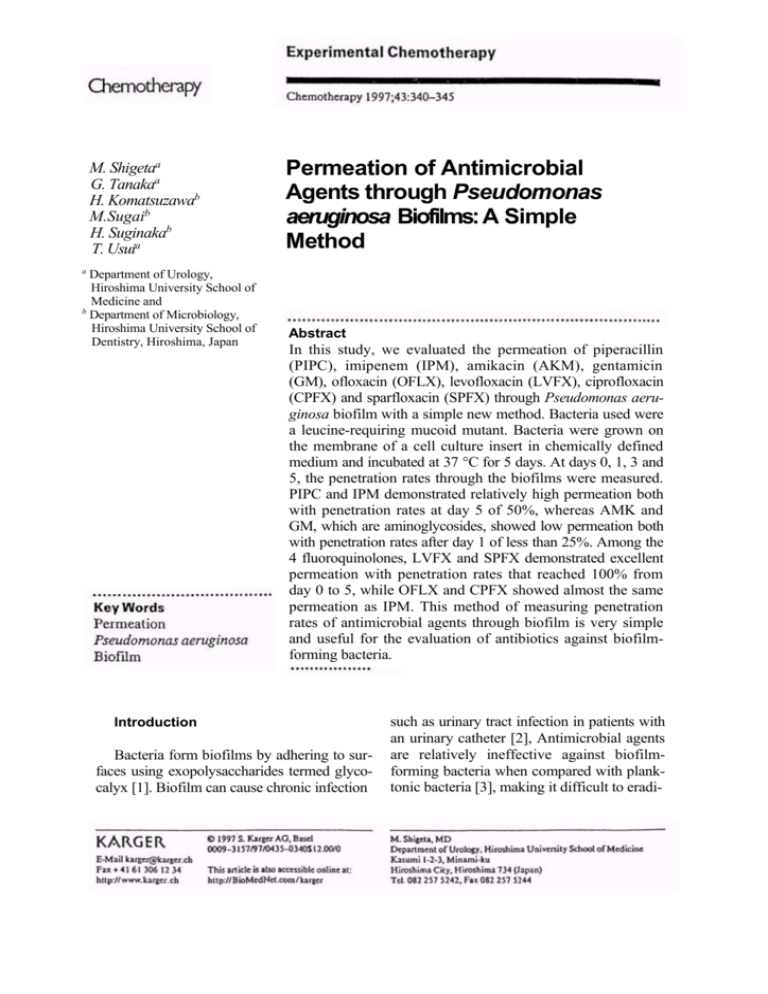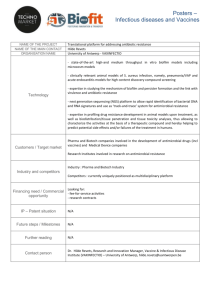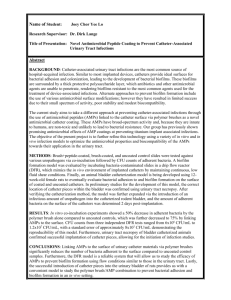M. Shigetaa G. Tanakaa H. Komatsuzawab M.Sugaib H. Suginakab
advertisement

M. Shigetaa G. Tanakaa H. Komatsuzawab M.Sugaib H. Suginakab T. Usuia Permeation of Antimicrobial Agents through Pseudomonas aeruginosa Biofilms: A Simple Method a Department of Urology, Hiroshima University School of Medicine and b Department of Microbiology, Hiroshima University School of Dentistry, Hiroshima, Japan Abstract In this study, we evaluated the permeation of piperacillin (PIPC), imipenem (IPM), amikacin (AKM), gentamicin (GM), ofloxacin (OFLX), levofloxacin (LVFX), ciprofloxacin (CPFX) and sparfloxacin (SPFX) through Pseudomonas aeruginosa biofilm with a simple new method. Bacteria used were a leucine-requiring mucoid mutant. Bacteria were grown on the membrane of a cell culture insert in chemically defined medium and incubated at 37 °C for 5 days. At days 0, 1, 3 and 5, the penetration rates through the biofilms were measured. PIPC and IPM demonstrated relatively high permeation both with penetration rates at day 5 of 50%, whereas AMK and GM, which are aminoglycosides, showed low permeation both with penetration rates after day 1 of less than 25%. Among the 4 fluoroquinolones, LVFX and SPFX demonstrated excellent permeation with penetration rates that reached 100% from day 0 to 5, while OFLX and CPFX showed almost the same permeation as IPM. This method of measuring penetration rates of antimicrobial agents through biofilm is very simple and useful for the evaluation of antibiotics against biofilmforming bacteria. Introduction Bacteria form biofilms by adhering to surfaces using exopolysaccharides termed glycocalyx [1]. Biofilm can cause chronic infection such as urinary tract infection in patients with an urinary catheter [2], Antimicrobial agents are relatively ineffective against biofilmforming bacteria when compared with planktonic bacteria [3], making it difficult to eradi- cate the pathogens in chronic urinary tract infection with catheter. It is suggested that this resistance is due to a barrier effect of glycocalyx, and/or to a lower growth rate caused by nutrient deprivation [4] and/or to β-lactamase production [5], We recently reported that the growth rate is an important factor in the bactericidal activity of β-lactams against biofilm-forming bacteria, but not for that of fluoroquinolones, using a leucine-requiring Pseudomonas aeruginosa mutant (HU1), the growth rate of which could be controlled by varying the leucine concentration in the medium [6]. In this study, we used leucinerequiring P. aeruginosa HU1 grown at a low concentration of leucine as a model of slowgrowing biofilm-forming bacteria and evaluated the permeation of antimicrobial agents through HU1 biofilms with a simple new method. Materials and Methods Bacterial Strain A leucine-requiring mucoid mutant, HU1, was used. This strain is a derivative of the mucoid clinical strain 4568 isolated from the urine sample of a patient with urinary tract infection at the Hiroshima University Hospital by chemical mutagenesis, as described previously [6]. Escherichia coli NIHJ and Staphylococcus aureus FDA 209P were used as control strains for evaluation of antibiotic activities. Antimicrobial Agents The antibiotics used were piperacillin (PIPC; Toyama Chemical, Tokyo, Japan), imipenem (IPM; Banyu Seiyaku, Osaka, Japan), amikacin (AMK; Meiji Seika, Tokyo, Japan), gentamicin (GM; Schering Plau, Osaka, Japan), ofloxacin (OFLX; Daiichi Seiyaku, Osaka, Japan), levofloxacin (LVFX; Daiichi Seiyaku), ciprofloxacin (CPFX; Bayer, Leverkusen, Germany) and sparfloxacin (SPFX; Dainippon Pharmacy, Osaka, Japan). These drugs were provided by the respective pharmaceutical companies. Susceptibility Testing The minimum inhibitory concentrations (MICs) of PIPC, IPM, AMK, GM, LVFX, CPFX and SPFX were determined by a microbroth dilution method. The medium used was trypticase-soy broth (TSB; Becton-Dickinson Microbiology System, Franklin Lakes, N.J., USA), and the initial suspensions, prepared by diluting broth cultures of HU1 overnight, contained 106 CFU/ml. The MIC was defined as the lowest concentration which prevented visible growth after incubation without shaking for 24 h at 37 °C. Medium The media used were TSB and minimum medium (MM) (7 g of K2HP04, 3 g of KH2PO4,0.5 g of sodium citrate, 0.1 g of MgSO4-7 H2O, 1 g of (NH4)2SO4 and 3 g of glucose, dissolved in 1,000 ml of water), containing 100 mg/1 of leucine (L100). Biofilm Formation on the Membrane of the Cell Culture Insert Cells were grown overnight in 10ml of TSB at 37 °C and washed with phospate-buffered saline (PBS). Bacteria were resuspended in 4 ml of MM containing LI00 to 107 CFU/ml and then placed into cell culture inserts (0.4 μm, 23.4 mm in diameter, BectonDickinson Labware, Franklin Lakes, NJ. USA) (fig. 1). Cell culture inserts were placed into 6-well cell culture plates (Becton-Dickinson Labware; one cell culture insert/well) and incubated for 2 h at 37° C to allow the bacteria to adhere to the membrane at the bottom of each insert. After several washings with PBS to remove nonadherent cells, the bacteria on the membrane of the cell culture insert were resuspended in 4ml of MM containing LI00 at 37 °C (day 0). The medium was changed every 8 h following several washings with PBS. Measurement of Permeation of Antimicrobial Agents through HU1 Biofilms A cell culture insert containing biofilm incubated in MM containing L100 was removed at days 0, 1, 3 and 5. After several washings with PBS to remove nonadeherent cells, the bacteria on the membrane of the cell culture insert were incubated in 4 ml of MM containing LI00 together with respective antimicrobial agents (100μg/ml). The cell culture inserts were suspended in 6-well cell culture plates containing 4 ml of fresh TSB. At 3 h, 200 μl of TSB from these cell culture plates were taken and passed through a filter (sterile Acrodisk, 0.2 μm, 13mm in diameter, HT TufTryn membrane; Gelman Science, Ann Arbor, Mich, USA) to measure the concentration of antimicrobial agent penetrated through the HU1 biofilm by a microdilution method. The concentrations of penetrated antimicrobial agent at day 0 were defined as 100% for each Fig. 1. Schema of cell culture insert and cell culture plate. Fig. 2. Growth curve of biofilm-forming mucoid P.aeruginosa HU1 (leucine-requiring mutant) on a cell desk during incubation in MM in the presence of LI 00. agent. E. coli NIHJ was used as the indicator bacterium for the assay of PIPC, IPM, OFLX, LVFX, CPFX and SPFX. S. aureus FDA 209P was used for the assay of AMK and GM. All experiments were performed in triplicate, and the results were expressed as the median percentage. Results Minimum Inhibitory Concentrations The MICs of PIPC, IPM, AMK, GM, OFLX, LVFX, CPFX and SPFX for the planktonic HU1 were 8, 4, 2, 1, 0.5, 0.1, 0.1 and 0.4 μg/ml, respectively. Growth Curve of Biofilm-FormingHUl Growth curves of biofilm-forming HU1 on cell desks (round type, 13.5 mm in diameter; Sumitomo, Tokyo, Japan) suspended in MM containing LI00 are shown in figure 2. This method has been used in a previous study [6]. The growth rate of biofilm-forming HU1 was very slow. The growth curve of those cultured in MM containing LI00 showed biphasic growth: the cells grew exponentially until day 3 and remained stationary afterwards. The approximate doubling time of biofilm-forming HU1 in the exponential growth phase was 7.6 h. Permeation of Antimicrobial Agents through HUlBiofilm The penetration rate of antimicrobial agents through HU1 biofilm is shown in figure 3a, b. PIPC and IPM, which are β-lactams, demonstrated relatively high permeation both with penetration rates at day 5 of 50%, while AMK and GM, which are aminoglycosides, showed low permeation, both with penetration rates after day 1 of less than 25%. Among the 4 fluoroquinolones, LVFX and SPFX demonstrated excellent permeation antibiotic diffusion [7]. Baltimore et al. [8] have reported that alginate, a major component of glycocalyx produced by mucoid-type P. aeruginosa, is an important factor in the resistance to aminoglycosides, but not to βlactams [8], This can be explained by differDiscussion ences in the charges of antibiotics; aminoglyIt has been suggested that the barrier effect cosides are positively charged, while β-lacof glycocalyx is an important factor in the tams are uncharged. The former bind to the resistance of biofilm to antimicrobial agents electronegative alginate, while the latter do [4] and that glycocalyx may directly protect not. Therefore, aminoglycoside activity is dithe bacteria against antibiotics by retarding minished in the presence of alginate [8]. On both with penetration rates of 100% from day 0 to 5, while OFLX and CPFX showed almost the same permeation as IPM. Table 1. pK and charge of antimicrobial agents at pH 6.6 ND = Not determined; Ν = not charged; Ρ = positively charged. the other hand, Hodges and Gordon [9] have reported the possibility of a non-charge-related binding of antimicrobial agents to alginate because ciproxan and β-lactams were inhibited by alginate at a neutral pH. The pK of each antimicrobial agent used in this study is shown in table 1. At pH 6.6, which is the pH of MM containing LI00, AMK is positively charged, and the other antibiotics are uncharged. Our results supported Hodges' [9] theory and suggested that permeation of antimicrobial agents through biofilm varied depending on the type of antibiotic and the age of the biofilm. With the method of Yasuda et al. [10], we confirmed that the glycocalyx in HU1 biofilm incubated in MM with L100 contained alginate (data not shown). In spite of the presence of alginate, LVFX and SPFX demonstrated excellent permeation from day 1 to 5, and their permeation was not affected at all. PIPC, IPM, OFLX and CPFX showed relatively high penetration rates. However, on day 5, the penetration of these antibiotics was inhibited to 50%. Lastly, aminoglycosides were the most strongly inhibited of all agents tested, with penetration rates after day 1 of only 25%. The results of this and a previous study [6] suggest that a barrier effect of glycocalyx and a lower growth rate are important factors in the resistance of biofilm-forming bacteria to an- timicrobial agents. For the treatment of biofilm-forming bacteria, antibiotics should be selected based on good permeation through glycocalyx and good bactericidal activity against slow-growing bacteria. Our new method may prove useful for evaluating the clinical potential of antimicrobial agents against biofilm-forming bacteria. Acknowledgements This study was partially supported by an educational grant from the Tsuchiya foundation, Hiroshima, Japan. References 1 Costerton JW, Irvin RT, Cheng KJ: The bacterial glycocalyx in nature and disease. Annu Rev Microbioi 1981;35:299-324. 2 Hoyle BD, Alcantara J, Costerton JW: Pseudomonas aeruginosa biofilm as a diffusion barrier to piperacillin. Antimicrob Agents Chemother!992;36:2054-2056. 3 Prosser BLT, Taylor D, Dix BA, Cleeland R: Method of evaluating effect of antibiotics on bacterial biofilm. Antimicrob Agents Chemother 1987;31:1502-1506. 4 Gilbert P, Collier PJ, Brown MRW: Influence of growth rate on suscepti bility to antimicrobial agents. Biofilm, cell cycle, dormancy, and strin gent response. Antimicrob Agents Chemother 1990;34:1865-1868. 5 Giwercman B, Jensen ET, Hoiby N, Kharazmi A, Costerton JW: Intro duction of β-lactamase production in Pseudomonas aeruginosa biofilm. Antimicrob Agents Chemother 199l;35:1008-1010. 6 Shigeta M, Komatsuzawa H, Sugai M, Suginaka H, Usui T: The effect of growht rate of Pseudomonas aeru ginosa biofilms on the susceptibility to antimicrobial agents. Chemother apy, in press. 7 Gordon CA, Hodges NA, Marriott C: Antibiotic interaction and diffu sion through alginate and exopolysaccharide of cystic fibrosis-derived Pseudomonas aeruginosa. Antimi crob Agents Chemother 1988;22: 667-674. 8 Baltimore RS, Cross AS, Dobek AS: The inhibitory effect of sodium algi nate on antibiotic activity against mucoid and non-mucoid of P. aeruginosa. J Antimicrob Chemother 1987;20:815-823. 9 Hodges NA, Gordon CA: Protection of Pseudomonas aeruginosa against ciprofloxacin and β-lactams by ho mologous alginate. Antimicrob Che mother 1991;35:2450-2452. 10 Yasuda H, Ajiki Y, Kawada H, Yokota T: Interaction between biofilms formed by Pseudomonas aeruginosa and clarithromycin. Antimicrob Agents Chemother 1993;37:17491755.







